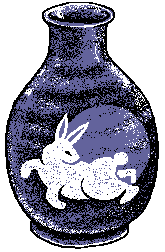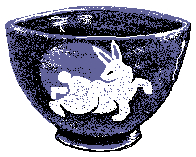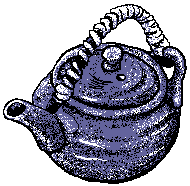|
Many
Japanese households have one of these appliances to keep a
ready supply of hot water for daily tea. Any serious tea drinker
would want one!
|
|
|
|
|
| |
|
|
No
presentation on Japanese food could be considered complete without
a few words concerning my two favorite drinks, rice wine and tea,
Japan's traditional national drinks of old. But to refer to them
merely as drinks is to belittle their lofty statue in Japanese
society, for these two are so highly regarded that they have been
given the honorific titles of o-cha and o-sake
(the "o" being a title of honor).
|
|
It
is said that the gods first drank sake and so it is still used
in religious rites, and placed on family alters to pay respect
to deities and the cherished dead. Marriage ceremonies include
ritual sake drinking and at many annual festivals sake is consumed
in great amounts because the gods love sake and clearly those
who drink the rice wine are closer to the divine.
The
word sake is actually a general reference to alcoholic beverages,
the word o-sake or the more precise nihonshu
(literally meaning Japanese liquor) is used by the sake
tsu (connoisseur) when referring to the full bodied rice
wine. Nihonshu of course is brewed from rice and there are many
grades and styles from which to choose.
|

|
|
Junmai-shu
is a pure rice wine without any additives and it's the only variety
allowed to be imported into the United States. It is said that
this style of o-sake is closest to the drink as it was in the
Edo period. The Japanese government specifies that the alcoholic
content of nihonshu be around 15 to 16.5 percent.
O-sake
comes sweet (amakuchi), or dry (karakuchi).
The casual drinker or non-connoisseur enjoys the "lighter" sweetish
taste of amakuchi, but the tsu much prefers the heavier dry style
of o-sake. O-sake can be served both cold or hot, depending upon
your mood or the dictates of the season. Hot summer days are made
more tolerable by serving chilled o-sake, some say that this is
the only way to drink rice wine as it is more flavorful and the
alcohol is not so quickly absorbed into your system. Simply keep
your bottle of o-sake in the refrigerator with the sake flask
(called, tokkuri), and it's cups (sakazuki),
and serve when thoroughly chilled.
|

|
The
cold winter season is the time for hot o-sake, but be careful!
Warm o-sake is so delicious and smooth that one can easily drink
too much of it! To warm your o-sake, pour it into a small ceramic
flask and place the flask in a small sauce pan filled with cold
water. Bring the water to a slow boil (but don't let it boil!
Boiling the o-sake damages it's flavor). When you dip your finger
into the rice wine and it's very warm then you're ready to drink.
|
|
O-sake
is best appreciated when there is something to eat, even if it
is only a humble offering of tsukemono (pickles).
O-sake goes well with fish dishes as well as the popular stews
(nabemono), of winter. Since o-sake is made from
rice it is considered redundant to drink o-sake while eating rice,
so drinking stops before the rice is served! Etiquette
demands that one should always pour o-sake for others but never
for oneself, when a guest or friend's cup is empty, fill it! Remember
to also lift your cup from the table when o-sake is being poured
for you. When drinking with friends or associates a hearty "Kampai!"
("to the bottom of the cup!"), is the toast most often heard.
Whether drinking with friends or alone, you are sure to love nihonshu...
the drink of the gods.
|
|
Tea
has long been associated with Japan but the drink actually came
from China and was imported into Japan in the 9th century by returning
monks. The Chinese word for tea is cha, and the
Japanese added the honorific prefix. Tea drinking didn't became
popular until the 12th century when the elites of Japan began
to enjoy mat-cha, a high quality powdered green
tea.
Tea
was closely associated with the clergy, and Zen Buddhism gave
birth to cha-do (the "way of tea"...
often called the tea ceremony by Westerners). It was thought
that ritual preparation and enjoyment of tea could help one to
attain enlightenment.
|
 |
Drinking
o-cha didn't become popular amongst the masses until the 18th
century, when tea leaves began to be used to make the drink.
Tea drinking soon became a national custom with everyone from
the clergy to the commoner drinking steeped green tea. Today
o-cha is as popular as ever, with Japan producing well over
one hundred thousand tons of tea a year! There are many varieties
of tea and they are all graded according to quality.
At the
bottom of this grading scale is a tea known as ban-cha,
which is typically available in supermarkets and restaurants.
Despite the low grade the tea is still very good and it's
easy to fall into the pattern of making one or two pots of
ban-cha a day! When making tea, never place the leaves into
boiling water as this results in a drink that is much too
bitter. The proper way to make tea is to first boil the water
and then pour it into a teapot. Loose tea leaves are then
added and allowed to steep for no more than five minutes before
drinking (the tea to water ratio is a matter of personal taste,
but 2 1/2 cups of hot water to a tablespoon of tea is about
right).
Other
inexpensive teas to enjoy would be genmai-cha, which
is a combination of green tea and roasted rice kernels. Genmai
has a rich, nutty, smoky flavor. Mugi-cha tea is
made from roasted barley and is wonderful served hot, but it makes
a fine thirst quencher served cold in the summertime. Both of
these teas are made in the same way as ban-cha, but with the summer
version of mugi-cha, allow it to chill in the refrigerator before
serving.
Teas
that have higher ratings would be sen-cha and
gyokuro. Sen-cha is made from better quality leaves
that are picked with greater care, and this particular tea was
meant to be savored. Gyokuro is the finest tea available with
the leaves being the tender young buds from the finest bushes.
The crop of gyokuro is always small and so it is very expensive
and highly regarded. Whatever tea is used it must always be appreciated
for it's fresh, natural tastes. Japanese tea is never mixed
with lemon, sugar, or milk.
|

|
|